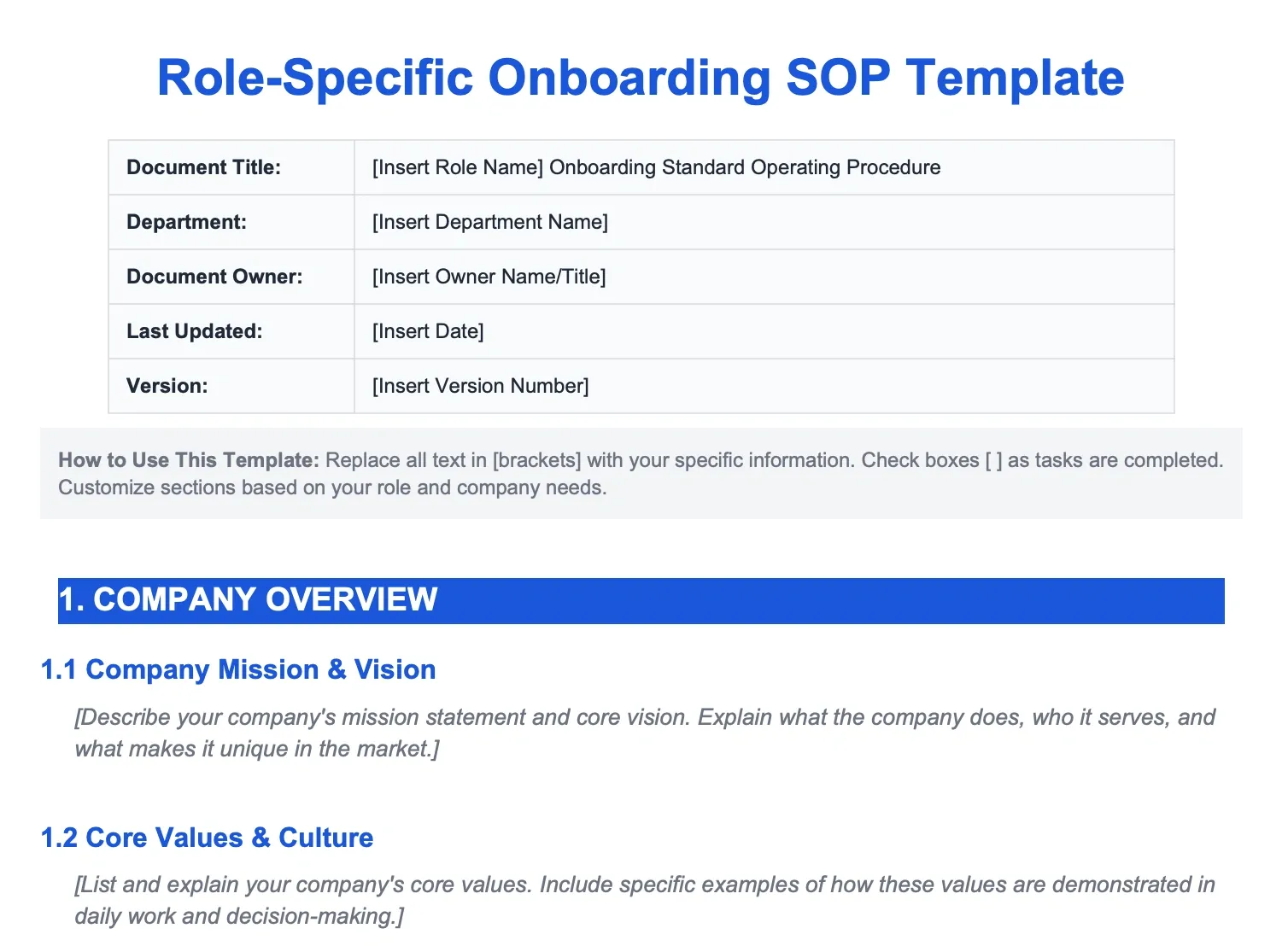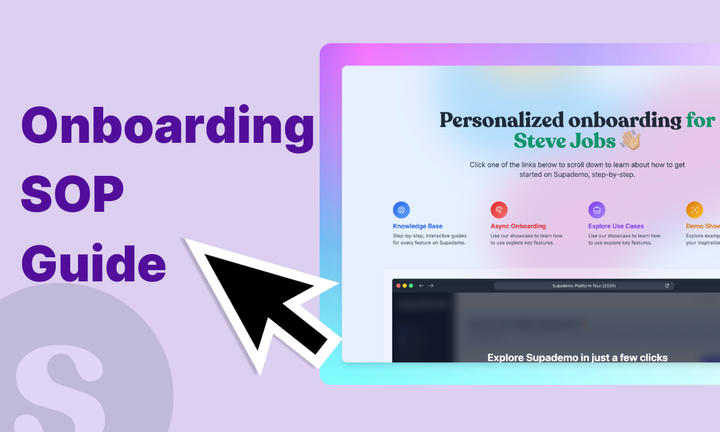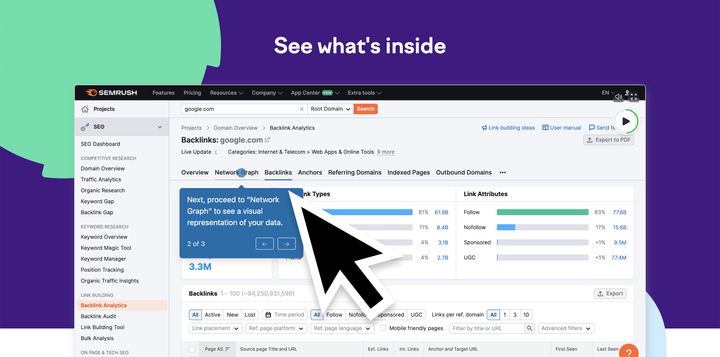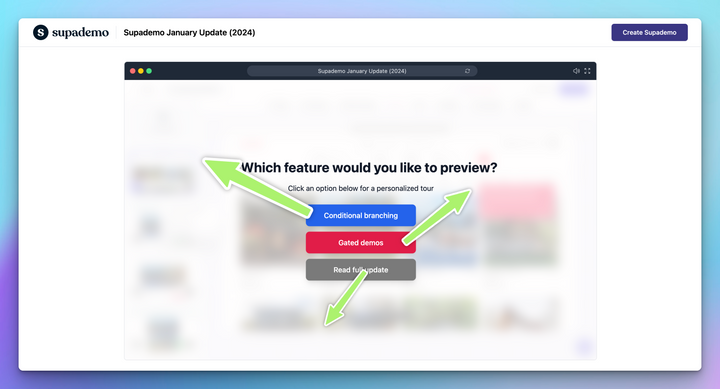According to a study, only 12% of workers believe their company handles new employee onboarding well. That means most companies are missing a basic step that affects everything from productivity to retention.
An onboarding standard operating procedure (SOP) provides every new hire with a clear path from day one. It removes guesswork, saves time, and gets people productive faster.
In this guide, we’ll walk you through what an onboarding SOP is, why you need one, and how to create yours step-by-step. So, let’s get started.
TL;DR
2. With a standard process, every new hire gets the same quality experience regardless of who manages their onboarding.
3. New employees reach full productivity faster when they follow a structured onboarding process.
4. Your SOP should evolve as your company grows and processes change.
5. Tools like Supademo let you create click-through guides that show new hires exactly what to do instead of making them read long documents.
What is an onboarding SOP?
An onboarding SOP is a documented set of steps that guides how you bring new employees into your company. It covers everything from sending the offer letter to completing their first project.
Think of it as a playbook that ensures every new hire gets the same quality experience, no matter who manages their onboarding. It keeps everyone aligned and prevents important steps from being missed.
Why is an onboarding SOP important?
You need an onboarding SOP because inconsistent onboarding creates problems. When different managers onboard people differently, some new hires succeed while others struggle. An SOP removes this randomness.
A clear process helps new hires understand what to expect, who to contact, and how to get things done. This builds confidence, reduces anxiety, and speeds up productivity.
It also helps existing teams. Instead of repeating the same instructions for every new hire, managers follow a set process and focus on higher-value work.
The result? A faster, smoother, and more scalable onboarding experience for everyone.
Benefits of having a standardized onboarding process
A standardized process gives you consistent results across all new hires. According to a study, good onboarding can improve how employees perform by up to 15% and make them put in more than 20% extra effort. When people know exactly what to do and how to do it, they work harder and deliver better results.
- Better retention: Employees who experience structured onboarding are more likely to stay with your company long term. Data shows that companies with well-planned onboarding see retention rates improve by 82%.
- Time savings: Managers save hours per new hire when they follow a documented process instead of figuring it out each time.
- Fewer errors: When steps are written down, critical tasks like compliance paperwork or system access don't get forgotten.
- Easier scaling: You can hire five people or fifty people using the same proven process, which makes the entire process easy to scale.
- Measurable improvements: With a standard baseline, you can track metrics like time-to-productivity and keep improving.
- Clear accountability: Everyone knows their role in onboarding, so nothing falls on one person.
Tools like Supademo help you create guided experiences that make onboarding faster, clearer, and more engaging for new hires.
How to create an SOP for the onboarding process?
Building your SOP for the onboarding process takes planning, but it’s well worth it. Here's how to create one that actually works.
Step 1: Define the scope and goals
Start by deciding what your SOP will cover. Will it include just the first week or the entire first 90 days? Will it cover all roles or specific departments?
Set clear goals for what you want to achieve. You can want new hires to complete compliance training in their first three days, or you can want them to ship their first project within 30 days. Write these goals down.
For example, a software company can set a goal that all new developers can run the codebase locally by the end of day one. This specific goal shapes what goes into the SOP.
Step 2: Map the onboarding process stages
Break onboarding into clear stages. Most companies use four stages:
- Preboarding: Everything that happens between accepting the offer and the first day.
- First day: The welcome experience and initial setup.
- First week: Core training, team introductions, and basic orientation.
- First 30-90 days: Role-specific learning, project work, and integration into the team.
Map out what needs to happen in each stage. This gives you the skeleton of your SOP.
Step 3: Identify key tasks and responsibilities
List every task that needs to happen during onboarding. Then assign each task to the right person or team. HR might handle benefits enrollment. IT might handle equipment setup. The manager might handle role training.
Be specific about who does what. Instead of "set up accounts," write "IT creates an email account and grants access to Slack, project management tool, and company drive within 24 hours of receiving new hire paperwork from HR."
Once you’ve mapped out these responsibilities, organize them into an HR onboarding checklist. This helps your team track progress, confirm task completion, and create a repeatable, efficient onboarding workflow for every new hire.
Step 4: Document each task and procedure
Document how each task should be completed. Go beyond text-based instructions by creating visual work instructions that show each step instead of just describing it. This makes complex processes easier to understand and follow.
Combine your written SOP with different formats such as an employee onboarding video, interactive walkthroughs for complex processes, annotated screenshots, and linked forms.
This mix supports different learning styles and improves knowledge retention.
An employee onboarding tool like Supademo lets you bring all these formats together in one place. You can turn processes like submitting an I-9 form into an interactive experience that promotes hands-on learning.
Here's an example of an employee onboarding kit you can create using Supademo:
Bullhorn, a global staffing software company, replaced static Rise 360 videos with interactive demos built with Supademo, cutting course creation time by 80% and increasing learner engagement by 50%.
Step 5: Include resources and checklists
Add links to all the resources a new hire needs. Include employee handbook, company policies, training materials, and contact lists. Create checklists for each stage so people can track their progress.
A checklist can look like:
- Complete benefits enrollment
- Set up direct deposit
- Finish security training
- Meet with the manager for a role overview
- Review the first project assignment
Checklists give new hires a sense of progress and make sure nothing gets missed.
Step 6: Review, test, and refine
Before you launch your visual SOP, test it with a real new hire. Watch them go through it and note where they get confused or stuck. Ask for feedback on what was helpful and what wasn't clear.
Use this feedback to improve the SOP. Then test it again with your next new hire. Keep refining based on what you learn.
Key components of an effective onboarding SOP
Every good SOP includes these essential components:
Preboarding activities
Preboarding happens before the first day. This is when you:
- Send the offer letter and employment contract: Give the new hire clear expectations and next steps.
- Collect required paperwork: Get tax forms, direct deposit information, and emergency contacts before day one.
- Order equipment and set up accounts: Make sure the laptop, phone, and system access are ready when they arrive.
- Assign a buddy or mentor: Pair them with someone who can answer questions and help them settle in.
Good preboarding makes the first day smooth. The new hire shows up to a ready workspace instead of waiting for IT to set things up.
First day procedures
The first day sets the tone for everything else. Your SOP should cover:
- Welcome and orientation: Give them a tour, introduce them to the team, and review the schedule for their first week.
- Equipment setup: Help them log into all systems and verify everything works.
- Initial employee training: Cover basic company policies, security protocols, and communication tools.
- First assignment: Give them a small, achievable task to complete by end of day.
For example, a new hire can spend their morning in orientation, their afternoon setting up accounts with IT, and their last hour reviewing the employee handbook. This structure prevents the overwhelming "here's everything at once" experience.
First week and beyond
After day one, your SOP should outline:
- Daily check-ins: The manager meets with the new hire for 15-30 minutes each day to answer questions.
- Essential training modules: New hires complete required training on tools, processes, and their specific role.
- Team integration: They attend relevant meetings, shadow team members, and start contributing to projects.
- 30-60-90 day milestones: Set clear goals for what they should accomplish in their first three months.
The first week builds knowledge. The first 30 days build competence. The first 90 days build confidence.
Role-specific tasks by team
Different teams handle different parts of onboarding:
- HR responsibilities: Benefits enrollment, compliance training, company policy review, and payroll setup.
- IT responsibilities: Equipment provisioning, account creation, security access, and technical onboarding.
- Manager responsibilities: Role training, goal setting, project assignments, and performance expectations.
- Employee responsibilities: Completing training, asking questions, meeting with team members, and taking ownership of their learning.
Your SOP should clearly show who does what, so nothing gets missed.
Training and development integration
Connect onboarding to your ongoing training programs. New hires should know what learning resources are available and how to access them.
Your LMS can serve as a single source of truth for both onboarding and continuous learning. Store everything from tutorials and SOPs to videos in one place for easy access.
With Supademo’s Demo Hubs, you can embed interactive guides and walkthroughs directly inside your LMS. This creates an interactive learning hub that delivers hands-on learning while keeping all training organized, engaging, and easy to find.
Check-ins and feedback mechanisms
Schedule regular check-ins at 30, 60, and 90 days. Use these to:
- Assess progress: See how the new hire is performing against their goals.
- Gather feedback: Ask what's working in the onboarding process and what isn't.
- Address concerns: Surface any issues early before they become bigger problems.
- Adjust the plan: Modify training or assignments based on how the new hire is doing.
These check-ins keep onboarding on track and show the new hire that their success matters.
Onboarding SOP templates and examples
You don't have to build your SOP from scratch. Templates give you a good starting point. Here are some of the effective template examples you can get started with based on your requirements:
1. New hire onboarding SOP template

2. 30-60-90 onboarding SOP plan template

3. Role-specific onboarding SOP template

Exploring different formats
Templates come in different formats. Word documents work for simple checklists. PDFs work for official documentation. In contrast, interactive demos work for software training.
For example, you can use a Word document to outline the first week schedule, a PDF for the employee handbook, and Supademo to create interactive guides for logging into your systems. Different formats serve different purposes.
Tips for using or creating a template
Start with an existing template and customize it for your company. Don't try to use a template exactly as written because your processes are unique.
- Remove what doesn't apply: If a template includes steps you don't need, delete them.
- Add your specific details: Replace generic instructions with your actual process, tools, and contacts.
- Test with a real person: Have someone follow the template and tell you where it's unclear.
- Keep it updated: Review your template every quarter and update it based on feedback and changes.
A good template saves you time but still needs your input to work well.
Using technology for your SOP onboarding
Technology makes SOP onboarding easier to manage and follow.
Modern tools let you create interactive experiences instead of static documents. New hires can click through actual processes instead of reading about them. This hands-on approach helps them learn faster.
For instance, instead of writing "Click on Settings, then Users, then Add New User," you can create a demo that shows exactly what to click. The new hire follows along by clicking the same spots. They learn by doing.
Supademo specializes in this approach. You record your screen once, and it creates an interactive demo that anyone can follow. You can add text explanations, highlight important areas, and branch the demo for different scenarios.
You can also track who completes each demo and where people get stuck. This data helps you improve your onboarding over time.
Other useful tools include:
- Project management software: To track onboarding tasks and deadlines.
- Learning management systems: Organize training content and track completion.
- Employee communication platforms: Keep all onboarding conversations in one place.
- HR systems: Automate paperwork and compliance tracking.
The right mix of tools depends on your company's size and needs. Start simple and add tools as you grow.
Common onboarding frameworks to consider
Several proven frameworks can guide your SOP structure. Here are some you need to know:
The 5 C's of onboarding is a popular framework:
- Compliance: Complete all legal and regulatory requirements.
- Clarification: Make sure the new hire knows their role and expectations.
- Culture: Introduce them to company values and how things work.
- Connection: Help them build relationships with team members.
- Check-in: Follow up regularly to ensure they're succeeding.
Another framework is the 30-60-90 day plan:
- First 30 days: Learn the basics, complete training, and understand the role.
- Next 60 days: Take on projects, contribute to team goals, and develop skills.
- Final 90 days: Work independently, achieve measurable results, and integrate fully.
These frameworks give you a proven structure to build on. Choose one that matches your company culture and adapt it to your needs.
Maintaining and updating your onboarding SOP
Your SOP isn't a one-time project. It needs regular updates to stay relevant. Review your SOP every quarter. Ask yourself:
- What changed: Did you add new tools, change processes, or update policies?
- What feedback did you get: What did recent new hires say about their experience?
- What metrics show: Are new hires reaching productivity faster or slower than before?
Make updates based on what you learn. If three new hires got confused about the same step, rewrite that section. If a new tool replaced an old one, update the instructions.
Assign someone to own the SOP. This person makes sure updates happen and that the document stays current. Without clear ownership, SOPs get outdated and stop being useful.
Create interactive onboarding guides with Supademo
Written SOPs help, but interactive demos work better. New hires learn faster when they can see and do rather than just read.
Traditional onboarding documents sit in a folder somewhere. People skim them once and forget where they are. When they need to complete a task, they can't remember the steps and have to ask for help. This creates bottlenecks and frustration.
Interactive demos solve this problem. Supademo lets you create click-through guides that live where your new hires work. They can follow along step-by-step, at their own pace, without interrupting anyone.
Here's what makes Supademo work well for onboarding:
- Guided HTML demos: Record any process once and turn it into an interactive demo. New hires click through the actual steps instead of reading about them.
- AI voiceovers: Add voice narration to explain each step. This helps people who learn better by listening.
- Personalization: Customize demos with the new hire's name and role-specific information. This makes onboarding feel personal even when it's automated.
- Analytics: See who completed each demo and where people got stuck. Use this data to improve your content.
- Demo hub: Launch a collection of interactive demos directly inside your app. New hires access training right where they work.
Whether you're onboarding software engineers who need to learn your codebase or sales reps who need to learn your CRM, Supademo makes the onboarding process more structured, clearer, and faster.
Turn your SOP into an interactive, click-through guide with Supademo.
Start creating for free today!
FAQs
How long should an onboarding SOP be?
Your SOP should be as long as it needs to cover all critical steps without extra fluff. Most effective SOPs run 10-20 pages, depending on role complexity. Focus on clarity and completeness rather than hitting a specific length.
Who should be involved in creating an onboarding SOP?
Include representatives from HR, IT, department managers, and recent new hires. HR knows compliance requirements, IT knows technical setup, managers know role expectations, and recent hires know what actually helped them. This mix gives you complete coverage.
How often should I update my onboarding SOP?
Review your SOP quarterly and update it whenever you change tools, processes, or policies. Also, update it based on feedback from new hires. Regular small updates keep it relevant without requiring major overhauls.
Can I use the same onboarding SOP for all roles?
Create a core SOP that covers company-wide elements like benefits and policies, then add role-specific sections for each department. This approach maintains consistency while addressing unique needs for different positions.
What's the difference between an onboarding SOP and an employee handbook?
An employee handbook covers policies, benefits, and company rules. An onboarding SOP covers the process of bringing someone into the company, including tasks, timelines, and who does what. You need both, and they complement each other.
How do I measure if my onboarding SOP is working?
Track time-to-productivity, new hire retention at 90 days, completion rates for training modules, and feedback scores from new employees. Compare these metrics over time to see if your SOP improvements are working.
What happens if a new hire doesn't follow the SOP?
First, find out why. The SOP could be unclear, too long, or missing key information. Use this as feedback to improve it. Then work with the new hire to get them back on track with the important steps.
How detailed should task instructions be in an SOP?
Detailed enough that someone unfamiliar with the process can complete it without help. Include screenshots, links, and step-by-step guidance. If you find people asking the same questions, that section needs more detail.




